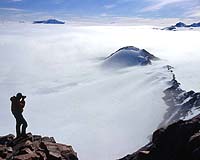
|

|

|

|
SPACEDAILY
MARSDAILY SPACEWAR SPACE TRAVEL ROCKET SCIENCE TERRADAILY DRAGON SPACE SPACEMART TECH SPACE SPACE DATABASE YESTERDAY'S SPACE CONTACT US AD RATES |
Arlington - Mar 26, 2003  Data collected by a new seismic observatory at the National Science Foundation's (NSF) Amundsen-Scott South Pole Station indicate that it is the quietest listening post on the planet for observing shudders produced by earthquakes around the world as they vibrate through the Earth.
Data collected by a new seismic observatory at the National Science Foundation's (NSF) Amundsen-Scott South Pole Station indicate that it is the quietest listening post on the planet for observing shudders produced by earthquakes around the world as they vibrate through the Earth. |
|
|
|
|
Japan Militarizes Its Space Program With Launch Of Dual Spy Sats Tokyo (AFP) Mar 28, 2003  Confronted with growing fears of the latest member of the nuclear bomb club North Korea, Japan has launched its first two spy sats Friday morning in a highly secret mission that Japan has released few details on beyond confirming the rocket's launch. "The rocket was launched at 10:27 am (0127 GMT)," said Yoshihiro Nakamura, spokesman for the National Space Development Agency (NASDA), minutes after the
launch.
Confronted with growing fears of the latest member of the nuclear bomb club North Korea, Japan has launched its first two spy sats Friday morning in a highly secret mission that Japan has released few details on beyond confirming the rocket's launch. "The rocket was launched at 10:27 am (0127 GMT)," said Yoshihiro Nakamura, spokesman for the National Space Development Agency (NASDA), minutes after the
launch.Sunny Days, Blue Skies For ESA And Satellite Meteorology  Paris (ESA) Mar 25, 2003
Paris (ESA) Mar 25, 2003The European Space Agency will join an international group that coordinates the planning and data procedures of weather satellites. Called the Coordination Group for Meteorological Satellites, the organisation provides a forum for meteorological satellite operators to explore ways to guarantee the maximum efficiency and usefulness of their systems on a global scale. |
Ion Trek Through Polymer Offers Better Batteries Idaho Falls - Mar 26, 2003
Idaho Falls - Mar 26, 2003Cell phones, CD players and flashlights all wear down batteries far faster than we might wish. But there's new hope, now that researchers at the Department of Energy's Idaho National Engineering and Environmental Laboratory (INEEL) have overcome another barrier to building more powerful, longer-lasting lithium-based batteries. NCAR's Data Archives Reach the One-Petabyte Stratosphere  Boulder - Mar 26, 2003
Boulder - Mar 26, 2003With the help of an innovative storage system, the National Center for Atmospheric Research (NCAR) has surpassed the one-petabyte mark in its data holdings, which range from satellite, atmosphere, ocean, and land-use data to depictions of weather and climate from prehistoric times to the year 2100 and beyond. |
Cosmic Particles Find Potential Role In Homeland Security Los Alamos - Mar 25, 2003
Los Alamos - Mar 25, 2003Fragments of cosmic rays could someday lead to the detection of smuggled nuclear materials, according to researchers at Los Alamos National Laboratory. New High-Purity Plutonium Sources Produced At Los Alamos  New Orleans - Mar 25, 2003
New Orleans - Mar 25, 2003For the first time since 1987, new high-purity plutonium sources for use as primary analytical chemistry standards have been produced at Los Alamos National Laboratory using a new extrusion method developed at the Laboratory. Plutonium sources used as standards in analytical chemistry must be of extreme purity, 99.99 percent pure, free of contaminants and surface oxidation. |
Engineers Create World's First Transparent Transistor Corvallis - Mar 26, 2003
Corvallis - Mar 26, 2003Engineers at Oregon State University have created the world's first transparent transistor, a see-through electronics component that could open the door to many new products. Time To Cut The Umbilical Cord And Roar Into Space  Pinson - Mar 24, 2003
Pinson - Mar 24, 2003In a recent "Opinion Space" article, one bright man asked the (valid) question "Is The Shuttle Fatally Flawed?" The answer can only be: yes (with an asterisk *) writes Jeff Wright. |
|
|
|
|
|
| The contents herein, unless otherwise known to be public domain, are Copyright 1995-2003 - SpaceDaily. AFP Wire Stories are copyright Agence France-Presse ESA Portal Reports are copyright European Space Agency. Additional copyrights may apply in whole or part to other bona fide parties. Advertising does not imply endorsement, agreement or approval of any opinions, statements or information provided by SpaceDaily on any web page published or hosted by SpaceDaily. Privacy Statement |